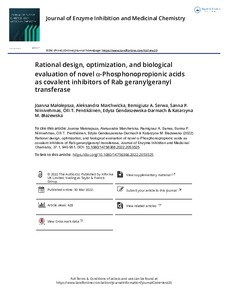Rational design, optimization, and biological evaluation of novel α-Phosphonopropionic acids as covalent inhibitors of Rab geranylgeranyl transferase
Malolepsza Joanna; Marchwicka Aleksandra; Serwa Remigiusz A.; Niinivehmas Sanna P.; Pentikäinen Olli T.; Gendaszewska-Darmach Edyta; Blazewska Katarzyna M.
Rational design, optimization, and biological evaluation of novel α-Phosphonopropionic acids as covalent inhibitors of Rab geranylgeranyl transferase
Malolepsza Joanna
Marchwicka Aleksandra
Serwa Remigiusz A.
Niinivehmas Sanna P.
Pentikäinen Olli T.
Gendaszewska-Darmach Edyta
Blazewska Katarzyna M.
TAYLOR & FRANCIS LTD
Julkaisun pysyvä osoite on:
https://urn.fi/URN:NBN:fi-fe2022081154022
https://urn.fi/URN:NBN:fi-fe2022081154022
Tiivistelmä
Rab geranylgeranyltransferase (GGTase-II, RGGT) catalyses the post-translational modification of eukaryotic Rab GTPases, proteins implicated in several pathologies, including cancer, diabetes, neurodegenerative, and infectious diseases. Thus, RGGT inhibitors are believed to be a potential platform for the development of drugs and tools for studying processes related to the abnormal activity of Rab GTPases. Here, a series of new alpha-phosphonocarboxylates have been prepared in the first attempt of rational design of covalent inhibitors of RGGT derived from non-covalent inhibitors. These compounds were equipped with electrophilic groups capable of binding cysteines, which are present in the catalytic cavity of RGGT. A few of these analogues have shown micromolar activity against RGGT, which correlated with their ability to inhibit the proliferation of the HeLa cancer cell line. The proposed mechanism of this inhibitory activity was rationalised by molecular docking and mass spectrometric measurements, supported by stability and reactivity studies.
Kokoelmat
- Rinnakkaistallenteet [27094]
